Comparison of 2D and 3D ultrasound methods to measure serial bladder volumes during filling: Steps toward development of non-invasive ultrasound urodynamics

Objectives: Non-invasive methods to objectively characterize overactive bladder (OAB) and other forms of voiding dysfunction using real-time ultrasound are currently under development but require accurate and precise serial measurements of bladder volumes during filling. This study’s objective was to determine the most accurate and precise ultrasound-based method of quantifying serial bladder volumes during urodynamics (UD).
Methods: Twelve female participants with OAB completed an extended UD procedure with the addition of serial bladder ultrasound images captured once per minute. Bladder volume was measured using three ultrasound methods: (1) Vspheroid: two-dimensional (2D) method calculated assuming spheroid geometry; (2) Vbih: 2D correction method obtained by multiplying Vspheroid by a previously derived correction factor of 1.375; and (3) V3D: three-dimensional (3D) method obtained by manually tracing the bladder outline in six planes automatically reconstructed into a solid rendered volume. These volumes were compared to a control (Vcontrol) obtained by adding UD infused volume and the volume of estimated urine production.
Results: Based on linear regression analysis, both Vbih and V3D were fairly accurate estimators of Vcontrol, but V3D was more precise. Vspheroid significantly underestimated Vcontrol.
Conclusions: Although the Vbih and V3D methods were more accurate than the more-commonly used Vspheroid method for measuring bladder volumes during UD, the V3D method was the most precise and could best account for non-uniform bladder geometries. Therefore, the V3D method may represent the best tool required for the continued development of non-invasive methods to diagnose OAB and other forms of voiding dysfunction.
Introduction
Methods
Experimental protocol
Image calculations
???ℎ?????= ?6(?*?*?) (Eqn. 1)
???ℎ=0.72*?*?*?=1.375*???ℎ????? (Eqn. 2)
Volume comparisons
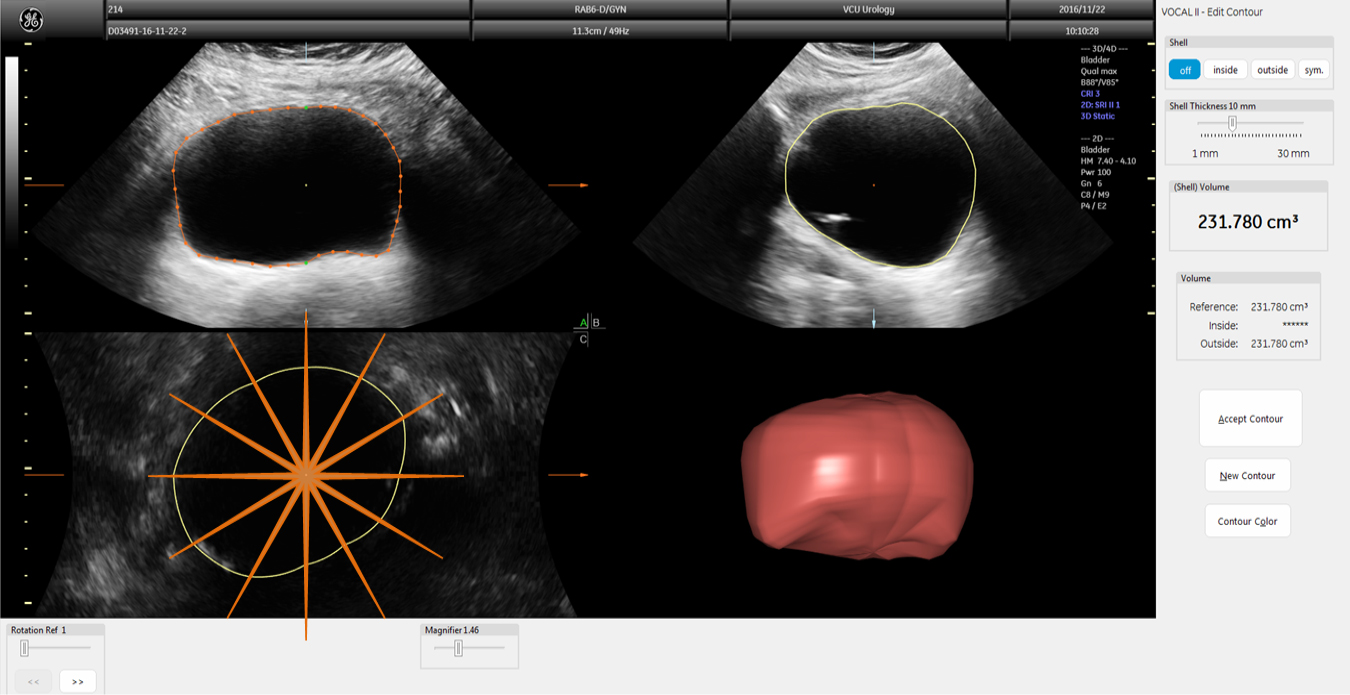
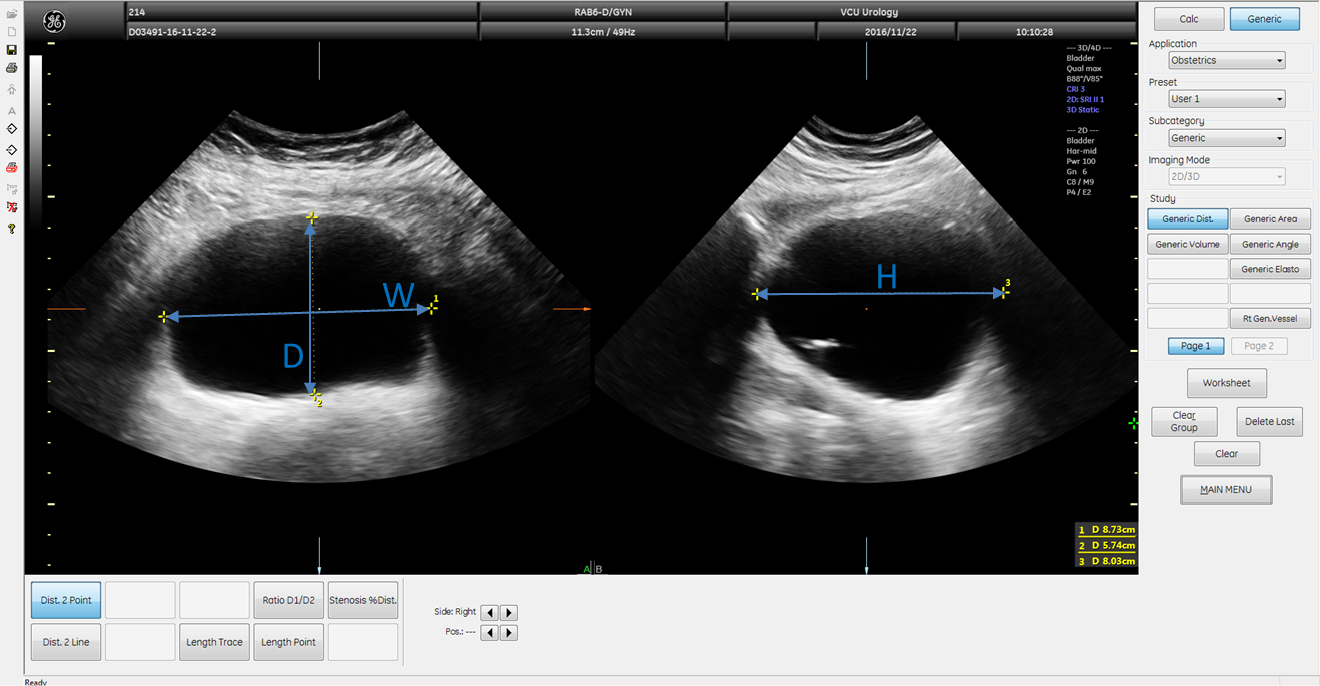
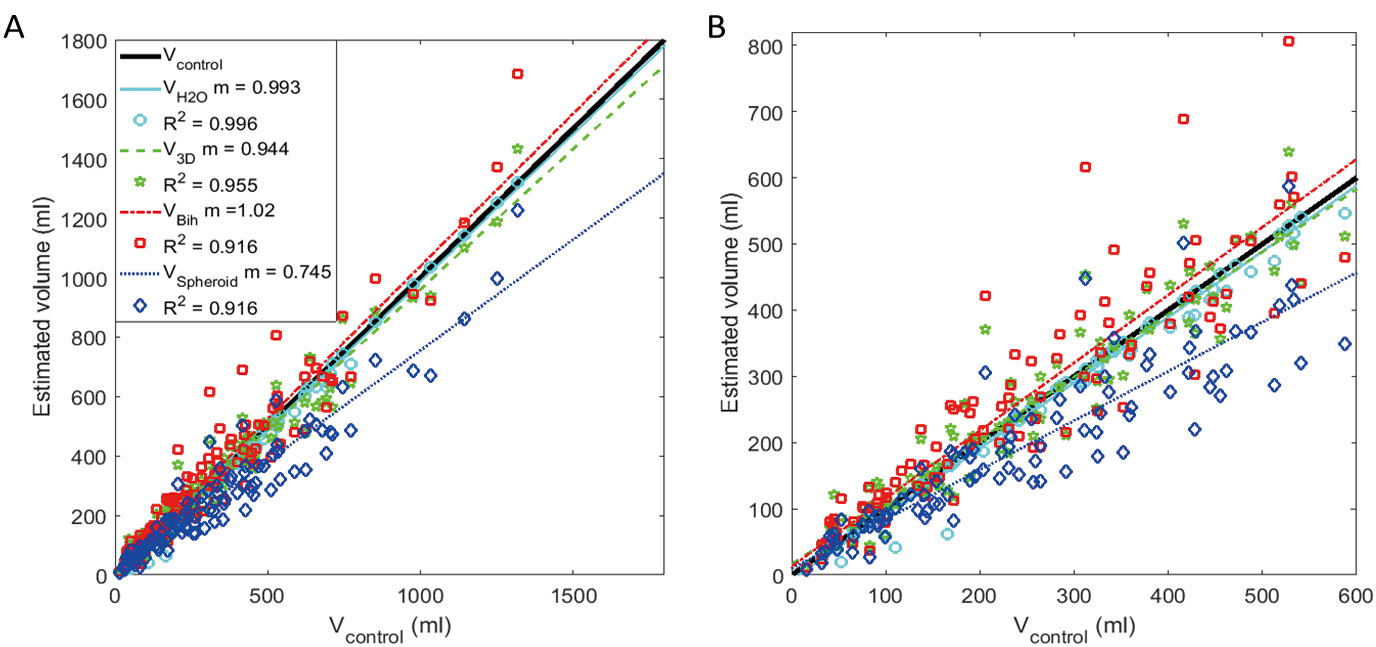
| Variable | Mean ± SEM | Range |
|---|---|---|
| Age (year) | 53.7 ± 11.1 | 28 to 67 |
| BMI (kg/m2) | 33.5 ± 9.7 | 19 to 54 |
| ICIq question 5a score | 3.25 ± 0.13 | 3 to 4 |
| ICIq total score | 9.67 ± 2.93 | 5 to 15 |
| Initial capacity (ml) | 553.8 ± 89.6 | 132 to 1172 |
| Capacity (ml) | 523.5 ± 91.9 | 99 to 1225 |
| Urine production (ml) | 27.4 ± 9.52 | 0 to 109.1 |
| Number of images | 9.2 ± 0.9 | 3 to 13 |
Results
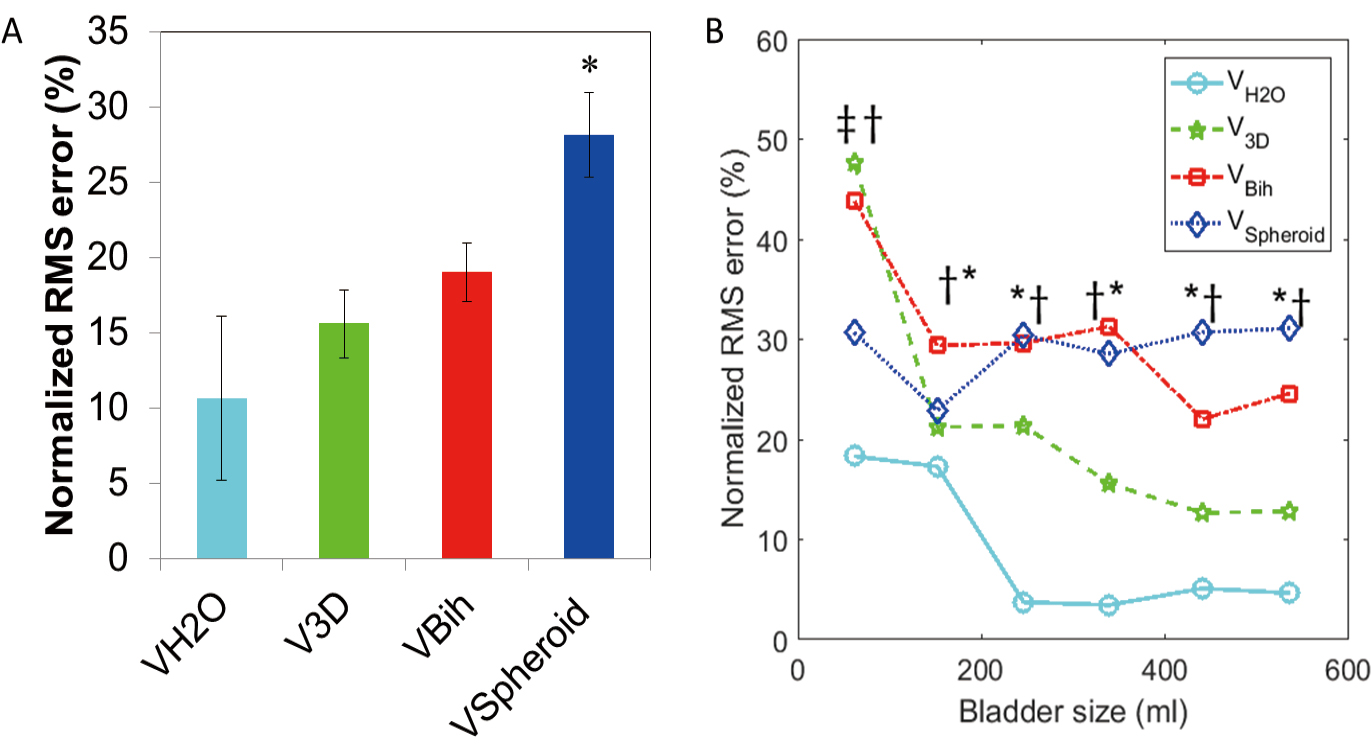
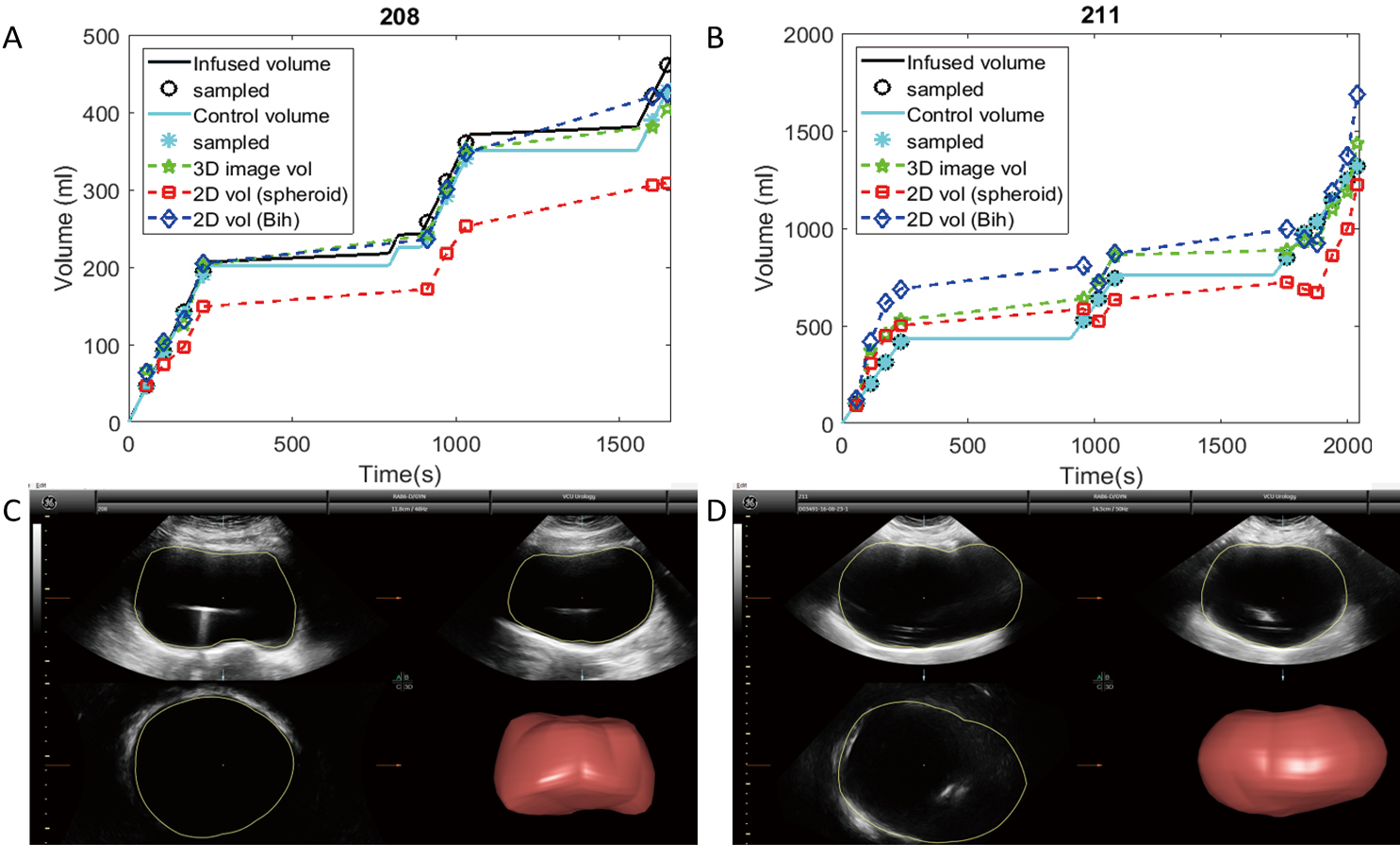
Discussion
-
-
-
-
Taylor 3rd JA, Kuchel GA (2006) Detrusor underactivity: Clinical features and pathogenesis of an underdiagnosed geriatric condition. J Am Geriatr Soc 54: 1920-1932. doi: https://doi.org/10.1111/j.1532-5415.2006.00917.x. [View Article] [PubMed] [Google Scholar]
-
Juma S (2014) Urinary retention in women. Curr Opin Urol 24: 375-379. doi: https://doi.org/10.1097/MOU.0000000000000071. [View Article] [PubMed] [Google Scholar]
-
Kaplan SA, Wein AJ, Staskin DR, Roehrborn CG, Steers WD (2008) Urinary retention and post-void residual urine in men: separating truth from tradition. J Urol 180: 47-54. doi: https://doi.org/10.1016/j.juro.2008.03.027. [View Article] [PubMed] [Google Scholar]
-
Haylen BT, Lee J (2008) The accuracy of post-void residual measurement in women. Int Urogynecol J Pelvic Floor Dysfunct 19: 603-606. doi: https://doi.org/10.1007/s00192-008-0568-0. [View Article] [PubMed] [Google Scholar]
-
Romanzi LJ, Groutz A, Heritz DM, Blaivas JG (2001) Involuntary detrusor contractions: correlation of urodynamic data to clinical categories. Neurourol Urodyn 20: 249-257. doi: https://doi.org/10.1002/nau.1002. [View Article] [PubMed] [Google Scholar]
-
Cassadó J, Espuña-Pons M, Díaz-Cuervo H, Rebollo P (2015) How can we measure bladder volumes in women with advanced pelvic organ prolapse?. Ultrasound Obstet Gynecol 46: 233-238. doi: https://doi.org/10.1002/uog.14678. [View Article] [PubMed] [Google Scholar]
-
Gammie A, Clarkson B, Constantinou C, Damaser M, Drinnan M, et al. (2014) International Continence Society guidelines on urodynamic equipment performance. Neurourol Urodyn 33: 370-379. doi: https://doi.org/10.1002/nau.22546. [View Article] [PubMed] [Google Scholar]
-
Nagle AS, Speich JE, De Wachter SG, Ghamarian PP, Le DM, et al. (2016) Non-invasive characterization of real-time bladder sensation using accelerated hydration and a novel sensation meter: An initial experience. Neurourol Urodyn 36: 1417-1426. doi: https://doi.org/10.1002/nau.23137. [View Article] [PubMed] [Google Scholar]
-
Ellerkmann RM, McBride AW, Dunn JS, Bent AE, Blomquist JL, et al. (2004) A comparison of anticipatory and postprocedure pain perception in patients who undergo urodynamic procedures. Obstet Gynecol 2004: 1034-1038. doi: https://doi.org/10.1016/j.ajog.2003.11.006. [View Article] [PubMed] [Google Scholar]
-
Ku JH, Kim SW, Kim HH, Paick J, Son H, et al. (2004) Patient experience with a urodynamic study: a prospective study in 208 patients. J Urol 171: 2307-2310. [PubMed] [Google Scholar]
-
Erdem E, Tunçkiran A, Acar D, Kanik EA, Akbay E, et al. (2005) Is catheter cause of subjectivity in sensations perceived during filling cystometry?. Urology 66: 1000-1003. doi: https://doi.org/10.1016/j.urology.2005.05.056. [View Article] [PubMed] [Google Scholar]
-
Heeringa R, de Wachter SGG, van Kerrebroeck PEV, van Koeveringe GA (2011) Normal bladder sensations in healthy volunteers: a focus group investigation. Neurourol Urodyn 30: 1350-1355. doi: https://doi.org/10.1002/nau.21052. [View Article] [PubMed] [Google Scholar]
-
Haylen BT, Frazer MI, Sutherst JR, Ashby D (1989) The accuracy of measurement of residual urine in women by urethral catheterisation. Br J Urol 63: 152-154. doi: https://doi.org/10.1111/j.1464-410X.1989.tb05153.x. [View Article] [PubMed] [Google Scholar]
-
Nagle AS, Klausner AP, Varghese J, Bernardo RJ, Colhoun AF, et al. (2017) Quantification of bladder wall biomechanics during urodynamics: A methodologic investigation using ultrasound. J Biomech 61: 232-241. doi: https://doi.org/10.1016/j.jbiomech.2017.07.028. [View Article] [PubMed] [Google Scholar]
-
Sturm RM, Yerkes EB, Nicholas JL, Snow-Lisy D, Diaz SD, et al. (2017) Ultrasound shear wave elastography: A novel method to evaluate bladder pressure. J Urol 198: 422-429. doi: https://doi.org/10.1016/j.juro.2017.03.127. [View Article] [PubMed] [Google Scholar]
-
Nenadic I, Mynderse L, Husmann D, Mehrmohammadi M, Bayat M, et al. (2016) Noninvasive evaluation of bladder wall mechanical properties as a function of filling volume: Potential application in bladder compliance assessment. PLoS One 11: doi: https://doi.org/10.1371/journal.pone.0157818. [View Article] [PubMed] [Google Scholar]
-
Hartnell GG, Kiely EA, Williams G, Gibson RN (1987) Real-time ultrasound measurement of bladder volume: a comparative study of three methods. Br J Radiol 60: 1063-1065. doi: https://doi.org/10.1259/0007-1285-60-719-1063. [View Article] [PubMed] [Google Scholar]
-
Poston GJ, Joseph AE, Riddle PR (1983) The accuracy of ultrasound in the measurement of changes in bladder volume. Br J Urol 55: 361-363. [PubMed]
-
Riccabona M, Nelson TR, Pretorius DH, Davidson TE (1996) In vivo three-dimensional sonographic measurement of organ volume: validation in the urinary bladder. J Ultrasound Med 15: 627-632. doi: https://doi.org/10.7863/jum.1996.15.9.627. [View Article] [PubMed] [Google Scholar]
-
Kusanovic JP, Nien JK, Gonçalves LF, Espinoza J, Lee W, et al. (2008) The use of inversion mode and 3D manual segmentation in volume measurement of fetal fluid-filled structures: comparison with virtual organ computer-aided analysis (VOCAL). Ultrasound Obstet Gynecol 31: 177-186. doi: https://doi.org/10.1002/uog.5242. [View Article] [PubMed] [Google Scholar]
-
Sætherhaug T, Fasting MH, Røset MAH, Naylor M. Blaas HK, et al. (2006). Repeatability of volume calculations of the fetal urinary bladder. Bladder 3: e24. [Google Scholar]
-
Colhoun AF, Klausner AP, Nagle AS, Carroll AW, Barbee RW, et al. (2016) A pilot study to measure dynamic elasticity of the bladder during urodynamics. Neurourol Urodyn 2016: 1086-1090. doi: https://doi.org/10.1002/nau.23043. [View Article] [PubMed] [Google Scholar]
-
Habteyes FG, Komari SO, Nagle AS, Klausner AP, Heise RL, et al. (2017) Modeling the influence of acute changes in bladder elasticity on pressure and wall tension during filling. J Mech Behav Biomed Mater 71: 192-200. doi: https://doi.org/10.1016/j.jmbbm.2017.02.020. [View Article] [PubMed] [Google Scholar]
-
Colhoun AF, Speich JE, Cooley LF, Bell 3rd ED, Barbee RW, et al. (2016) Low amplitude rhythmic contraction frequency in human detrusor strips correlates with phasic intravesical pressure waves. World J Urol 35: 1255-1260. doi: https://doi.org/10.1007/s00345-016-1994-0. [View Article] [PubMed] [Google Scholar]
-
Byun SS, Kim HH, Lee E, Paick J, Kamg W, et al. (2003) Accuracy of bladder volume determinations by ultrasonography: are they accurate over entire bladder volume range?. Urology 62: 656-660. doi: https://doi.org/10.1016/S0090-4295(03)00559-4. [View Article] [PubMed] [Google Scholar]
-
Peixoto-Filho FM, Sá R, Lopes L, Velarde L, Marchiori E, et al. (2007) Three-dimensional ultrasound fetal urinary bladder volume measurement: reliability of rotational (VOCAL™) technique using different steps of rotation. Arch Gynecol Obstet 2007: 345-349. doi: https://doi.org/10.1007/s00404-007-0360-2. [View Article][Google Scholar]
-
Raine-Fenning NJ, Clewes JS, Kendall NR, Bunkheila AK, Campbell BK, et al. (2003) The interobserver reliability and validity of volume calculation from three-dimensional ultrasound datasets in the in vitro setting. Ultrasound Obstet Gynecol 21: 283-291. doi: https://doi.org/10.1002/uog.61. [View Article] [PubMed] [Google Scholar]
-
Bih LI, Ho CC, Tsai SJ, Lai YC, Chow W (1998) Bladder shape impact on the accuracy of ultrasonic estimation of bladder volume. Arch Phys Med Rehabil 79: 1553-1556. doi: https://doi.org/10.1016/S0003-9993(98)90419-1. [View Article] [PubMed] [Google Scholar]
-
Hwang JY, Byun S, Oh S, Kim HC (2004) Novel algorithm for improving accuracy of ultrasound measurement of residual urine volume according to bladder shape. Urology 64: 887-891. doi: https://doi.org/10.1016/j.urology.2004.06.054. [View Article] [PubMed] [Google Scholar]
-
Ghani KR, Pilcher J, Rowland D, Patel U, Nassiri D, et al. (2008) Portable ultrasonography and bladder volume accuracy--a comparative study using three-dimensional ultrasonography. Urology 72: 24-28. doi: https://doi.org/10.1016/j.urology.2008.02.033. [View Article] [PubMed] [Google Scholar]
-
Nusee Z, Ibrahim N, Rus RM, Ismail H (2014) Is portable three-dimensional ultrasound a valid technique for measurement of postpartum urinary bladder volume?. Taiwan J Obstet Gynecol 53: 12-16. doi: https://doi.org/10.1016/j.tjog.2013.01.028. [View Article] [PubMed] [Google Scholar]
-
Beckers GM, van der Horst HJ, Frantzen J, Heymans MW (2013) The BladderScan BVI 6200® is not accurate enough for use in a bladder retraining program. J Pediatr Urol 9: 904-909. doi: https://doi.org/10.1016/j.jpurol.2012.12.013. [View Article] [PubMed] [Google Scholar]
-
Schnider P, Birner P, Gendo A, Ratheiser K, Auff E (2000) Bladder volume determination: portable 3-D versus stationary 2-D ultrasound device. Arch Phys Med Rehabil 81: 18-21. doi: https://doi.org/10.1016/S0003-9993(00)90215-6. [View Article] [PubMed] [Google Scholar]
-
Ahmad R, Hoogeman MS, Quint S, Mens JW, de Pree I, et al. (2008) Inter-fraction bladder filling variations and time trends for cervical cancer patients assessed with a portable 3-dimensional ultrasound bladder scanner. Radiother Oncol 89: 172-179. doi: https://doi.org/10.1016/j.radonc.2008.07.005. [View Article] [PubMed] [Google Scholar]
-
-
-

